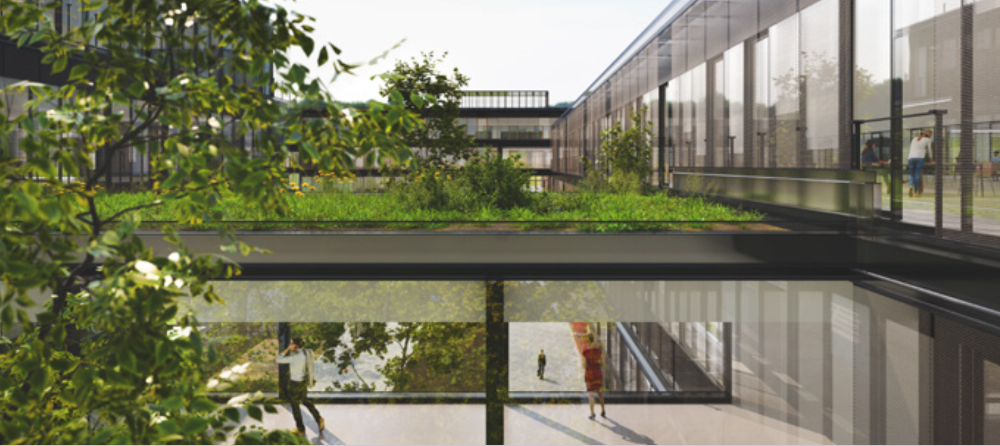Paving the way to net zero for designers
Contents |
[edit] Introduction
While it is undeniable that a substantial share of the UK’s annual 367 million tonnes of CO2 emissions emanate from oil and gas corporations, they are not solely responsible. With the Government’s net zero by 2050 target fast approaching, the carbon emissions of the UK’s non-domestic building stock are under the microscope. In 2020, the UK’s commercial buildings accounted for 23.6 million tonnes of carbon dioxide (about nine percent of the UK’s total emissions). And this was during the height of the pandemic when global emissions were down on average. So, retrofitting is pivotal to achieving net zero.
We explore this subject in our latest report, The Role of Retrofitting our Non-Domestic Buildings in the Race to Net Zero. We questioned 101 property and facilities heads from leading UK organisations and found that despite a resounding 76% of organisations expressing their commitment to net zero objectives, a mere quarter are genuinely deliberating how to integrate sustainable practices within their premises. The report further uncovers an array of factors that are impeding the much-needed retrofit revolution.
[edit] Unveiling the barriers to retrofit transformation
A central finding our study uncovered is the absence of board level discussion around the issue. More than half (55%) of the facility and property managers we spoke to say their boards fail to recognise retrofitting as a pivotal part of their net zero roadmap. What is more worrying, is the limited involvement facilities managers have in crucial decision-making processes. Nearly a quarter (23%) remain wholly uninvolved in any net zero strategic planning, and most are kept in the dark about their company’s five-year plan. Those who are engaged in net zero planning are facing a battle, with the carbon footprint of commercial buildings being consistently underestimated by boards. Astonishingly, 86% of organisations remain oblivious to how retrofitting can promote energy efficiency and reduce emissions. Misconceptions also pervade about the longevity of the UK’s current commercial building stock. More than a third of decision-makers mistakenly predict that a mere 39% of existing non-domestic structures will still be in use beyond 2050, while the actual figure will be closer to 70%. This, coupled with a presumption that transitioning to a new building is better for the environment, endangers the UK’s ability to achieve net zero.
[edit] Averting a looming retrofit crisis
How can this trajectory be rectified? Our research highlights five pivotal areas that with concentrated effort from expert support, including designers and wider multi- disciplinary teams of consultants and engineers, will help overcome the challenges of retrofitting:
[edit] Education
A lack of education is the main culprit for boards misunderstanding the scale of the issue. For example, 45% believe that if the grid is carbon neutral, they do not need to worry about their buildings being net zero. And almost a quarter (24%) do not feel that retrofitting will make a difference to their building’s carbon footprint. Yet moving to technologies such as heat pumps, that can deliver heat to our commercial spaces up to three times more efficiently than gas boilers, can dramatically reduce in-use emissions. There seems to be an underestimation of the environmental gains such technologies offer older buildings as part of a retrofitting programme.
[edit] Involvement
The role and expertise of facilities and property heads need to be more widely recognised and utilised by boards. One in five are not even privy to the strategic plans of their organisation. Yet, buildings can address many strategic decisions beyond net zero – such as energy security, energy costs, employer brand, staff wellbeing, and productivity – all issues occupying boards at the moment.
[edit] Budget
The way organisations budget for their buildings need to change. We found that over half (54%) set their building budget based on the previous year’s costs. Such a retrospective approach will not accommodate general inflation and energy price hikes, let alone a retrofit programme.
[edit] Expert support
Whilst many organisations want to do the right thing to achieve net zero, they are confused about how to achieve it. Our research identified a lack of clarity around whether new build or retrofitting is the better way to go and how to evaluate the possibilities. Even if they are convinced about retrofitting’s merits, a quarter of facilities heads do not know how to make a business case for a retrofit project to the board. There is also confusion around which of the many technologies and solutions available will deliver the best carbon gains. Such organisations need external support to scope the possibilities, make the case, and help facilities heads choose the right technologies and approach. This approach will ensure that the maximum carbon and sustainability gains are made and any barriers, such as the potential disruption to the wider organisation and drains on facilities team time, are kept to a minimum.
[edit] Incentives
Currently, there are no government incentives to encourage organisations to make their buildings more energy efficient. In fact, almost half (49%) say that current business rates operate to discourage retrofit. Without government intervention, achieving net zero hangs on the goodwill of boards whom we know misunderstand the scale of the problem.
[edit]
Even if these areas are addressed and there is an organisational consensus on retrofit integration, challenges persist. Among the facility heads surveyed, 31% identify operational disruptions as the biggest hurdle to implementing a retrofit programme. Consequently, almost half (48%) view building new as a cost-effective alternative. While grappling with potential disruptions is daunting, the enduring benefits of retrofit projects – encompassing net zero goals, enhanced efficiency, employee well-being, heightened productivity and talent retention – far outweigh transitory interruptions. Meticulous planning through multidisciplinary consultation, including with designers, will minimise disruption and ensure a seamless operation during retrofit initiatives.
[edit] Concluding thoughts
While public and private entities progressively embrace sustainability via waste reduction and digital transitions, the intrinsic role of buildings in an organisation’s carbon footprint remains overlooked. Progress hinges on a collaborative approach that tackles the five critical areas. Addressing these, through pragmatic solutions backed by expert guidance from designers and multi-disciplinary teams, will empower facilities heads and boards to steer the UK towards its ambitious net zero goals. To delve deeper into our insights, please explore the complete report, The Role of Retrofitting our Non-Domestic Buildings in the Race to Net Zero.
This article appears in the AT Journal issue 148 – Winter 2023 as 'Paving the way to net zero for designers' and was written by Matt Richards, Partner, Ridge.
--CIAT
Featured articles and news
Delivering for tenants; National Retrofit Hub
New report offers recommendations to strengthen energy efficiency standards to protect private renters.
Government consultations for the summer of 2025
A year of Labour, past and present consultations on the environment, the built environment, training and tax.
CMA competitiveness probe of major housing developers
100 million affordable housing contributions committed with further consultation published.
Homes England supports Greencore Homes
42 new build affordable sustainable homes in Oxfordshire.
Zero carbon social housing: unlocking brownfield potential
Seven ZEDpod strategies for brownfield housing success.
CIOB report; a blueprint for SDGs and the built environment
Pairing the Sustainable Development Goals with projects.
Types, tests, standards and fires relating to external cladding
Brief descriptions with an extensive list of fires for review.
Latest Build UK Building Safety Regime explainer published
Key elements in one short, now updated document.
UKGBC launch the UK Climate Resilience Roadmap
First guidance of its kind on direct climate impacts for the built environment and how it can adapt.
CLC Health, Safety and Wellbeing Strategy 2025
Launched by the Minister for Industry to look at fatalities on site, improving mental health and other issues.
One of the most impressive Victorian architects. Book review.
Common Assessment Standard now with building safety
New CAS update now includes mandatory building safety questions.
RTPI leader to become new CIOB Chief Executive Officer
Dr Victoria Hills MRTPI, FICE to take over after Caroline Gumble’s departure.
Social and affordable housing, a long term plan for delivery
The “Delivering a Decade of Renewal for Social and Affordable Housing” strategy sets out future path.
A change to adoptive architecture
Effects of global weather warming on architectural detailing, material choice and human interaction.
The proposed publicly owned and backed subsidiary of Homes England, to facilitate new homes.
How big is the problem and what can we do to mitigate the effects?
Overheating guidance and tools for building designers
A number of cool guides to help with the heat.
The UK's Modern Industrial Strategy: A 10 year plan
Previous consultation criticism, current key elements and general support with some persisting reservations.
Building Safety Regulator reforms
New roles, new staff and a new fast track service pave the way for a single construction regulator.




























